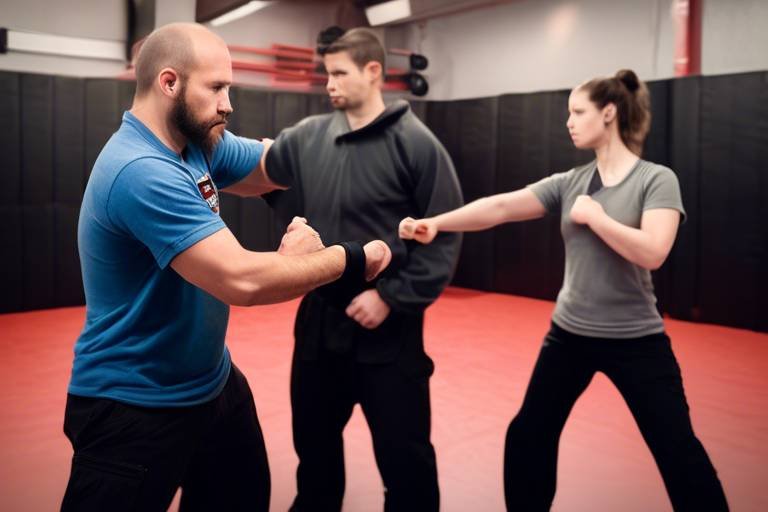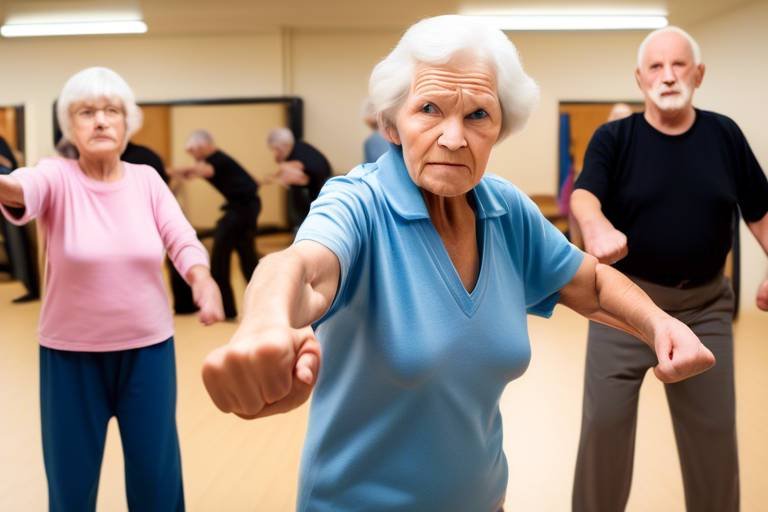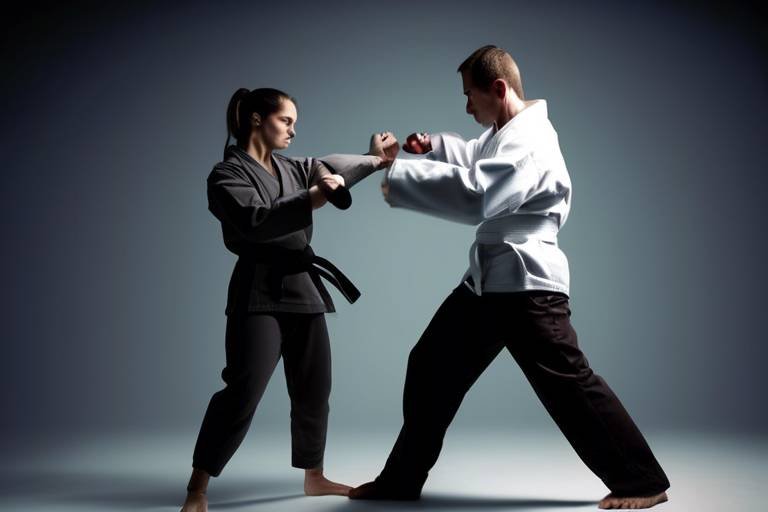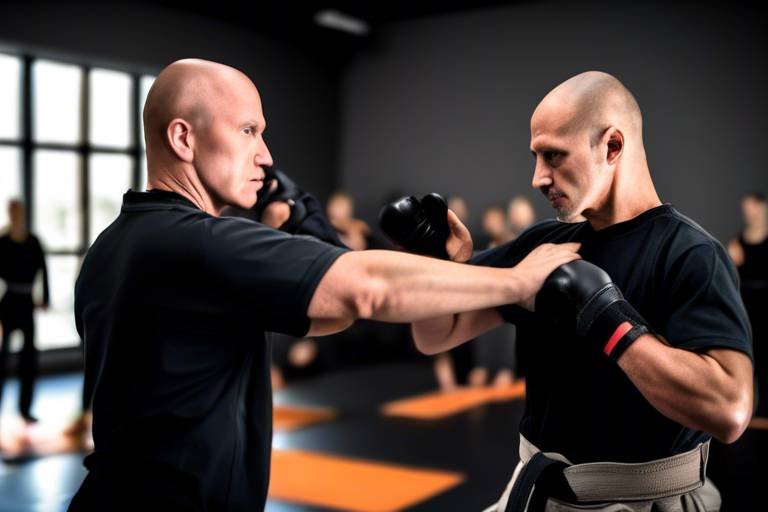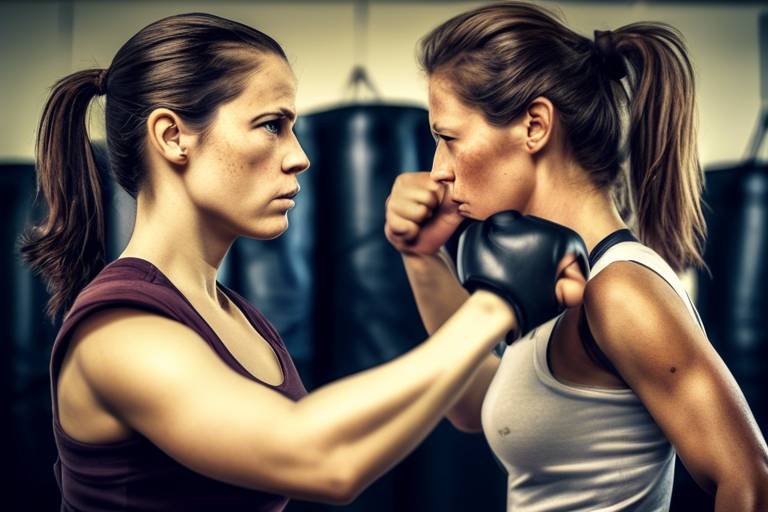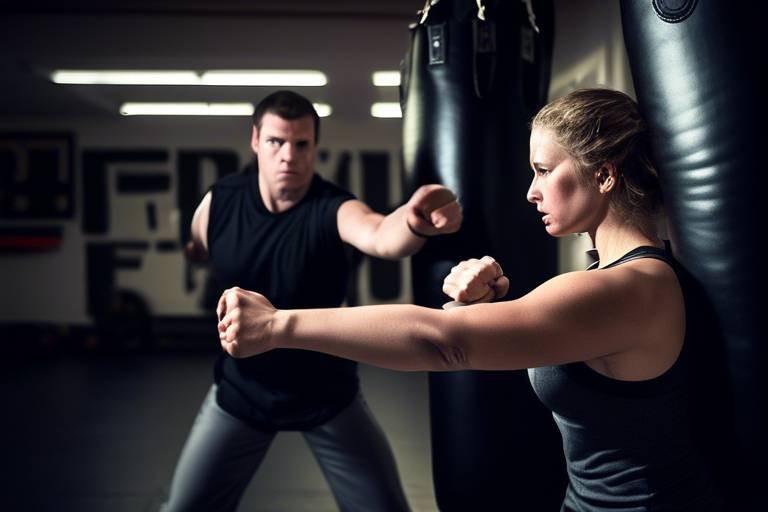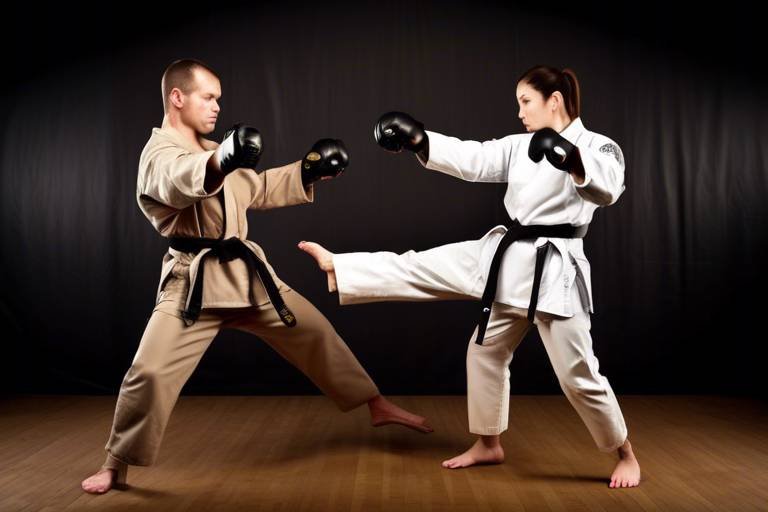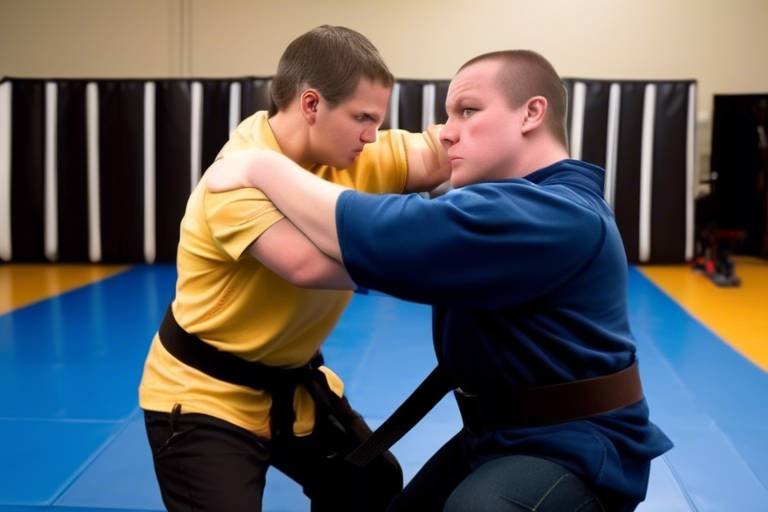Beyond Physical: The Psychological Component of Self-Defense Training
When we think of self-defense training, our minds often drift towards physical techniques, martial arts moves, and the sheer power of the body. However, there's a whole world beyond the physical realm that plays a crucial role in effective self-defense: the psychological component. It's intriguing to consider that the mind can be just as powerful, if not more so, than physical strength when it comes to protecting oneself. So, what does this mean for individuals seeking to enhance their self-defense skills? In this article, we will delve into the often-overlooked psychological aspects of self-defense training, emphasizing how mental preparedness and emotional resilience are vital for navigating real-world confrontations.
Have you ever been caught off guard in a situation that required quick thinking and decisive action? Mental preparedness is about being ready for the unexpected, and it's a game-changer in self-defense training. Imagine walking down the street, lost in thought, when suddenly a confrontation arises. If your mind is not prepared, your body may follow suit, leading to hesitation or panic. Cultivating a strong mental attitude can significantly enhance your ability to respond effectively. This involves training your brain to remain calm under pressure, developing a proactive mindset, and visualizing potential scenarios. By doing so, you create a mental framework that allows you to act rather than react, which is essential in self-defense situations.
Emotional resilience is another cornerstone of effective self-defense. When faced with a threatening situation, emotions like fear and anxiety can overwhelm even the most skilled martial artist. Developing emotional strength is vital for managing these feelings and maintaining clarity. Techniques such as deep breathing, positive self-talk, and grounding exercises can help you stay focused and composed. For instance, consider the analogy of a tree in a storm: while the winds may sway its branches, the roots remain firmly planted. Similarly, building emotional resilience allows you to stay rooted in your response, even when external pressures mount.
Fear and anxiety are natural responses to potential threats, but they don't have to dictate your actions. Learning to cope with these emotions is crucial for effective self-defense. One strategy is to acknowledge your feelings without judgment. Instead of trying to suppress fear, recognize it as a normal reaction that can serve as a signal to prepare for action. Techniques such as visualization and controlled breathing can help you regain composure. For example, envisioning a successful outcome can shift your mindset from one of fear to one of confidence and determination.
Visualization can be a powerful tool in self-defense training. By mentally rehearsing scenarios, you can enhance your performance and prepare yourself for real-life situations. Picture yourself confidently responding to a threat—what do you see, hear, and feel? This mental imagery can create neural pathways that make your responses more instinctive when faced with actual danger. The more vivid and detailed your visualization, the more effective it becomes in strengthening your mental preparedness.
Incorporating mindfulness into your self-defense training can significantly improve your awareness and decision-making abilities. Mindfulness encourages you to stay present in the moment, reducing distractions and enhancing focus. Techniques such as meditation, body scans, and mindful breathing can help you cultivate this awareness. By practicing mindfulness, you train your brain to recognize potential threats and respond appropriately, rather than reacting impulsively out of fear.
Confidence is a key component of effective self-defense. The more you train, the more you develop your skills, which naturally builds self-assurance. Think of it like learning to ride a bike: the first few attempts might be shaky, but with practice, you gain balance and control. Consistent training not only hones your physical abilities but also reinforces your mental fortitude. This confidence can be a deterrent in itself; often, would-be aggressors are less likely to target someone who exudes self-assuredness.
Situational awareness is crucial in self-defense. It's about being attuned to your surroundings and recognizing potential threats before they escalate. This heightened awareness allows you to make better decisions and avoid confrontations altogether. For instance, when walking in a crowded area, scanning your environment for unusual behavior can help you identify potential dangers early on. The more aware you are, the more equipped you become to protect yourself.
Identifying potential threats before they escalate is essential for self-defense. This involves understanding the dynamics of a situation and recognizing warning signs. For example, if you notice someone acting suspiciously or following you, your situational awareness can prompt you to take preventive measures. It's not about living in fear; it's about being proactive and informed. By developing this skill, you empower yourself to respond effectively and safely.
Quick decision-making can be the difference between safety and danger. In high-pressure scenarios, your ability to assess a situation and make swift choices is critical. Techniques such as role-playing, scenario training, and mental rehearsals can enhance your decision-making speed and accuracy. Just like a firefighter must make split-second decisions in emergencies, self-defense practitioners can benefit from training their brains to think quickly and effectively under stress.
- What is the psychological component of self-defense training?
It involves mental preparedness, emotional resilience, and situational awareness, which are crucial for effective responses in confrontational situations. - How can I build emotional resilience for self-defense?
Techniques such as mindfulness, positive self-talk, and deep breathing can help manage stress and maintain clarity during confrontations. - Why is situational awareness important in self-defense?
Being aware of your surroundings allows you to recognize potential threats early, enabling proactive decision-making to avoid confrontations.

The Importance of Mental Preparedness
Mental preparedness is often the unsung hero in the realm of self-defense training. While physical skills are undeniably important, the ability to maintain a clear mind during unexpected confrontations can make all the difference. Imagine finding yourself in a situation where your instincts kick in, but your mind is clouded with panic. That’s where mental preparedness comes into play. It’s about training your mind to stay calm, focused, and ready to react appropriately, no matter the circumstance.
One of the key aspects of mental preparedness is developing a strong mental attitude. This involves not just understanding the techniques of self-defense, but also embracing a mindset that enables you to face challenges head-on. Think of it as building a mental fortress—one that stands tall against the storms of fear and uncertainty. When you cultivate this mindset, you’ll find that you’re not just preparing for physical confrontations, but also for the emotional rollercoaster that often accompanies them.
Moreover, mental preparedness can significantly enhance your training outcomes. When you approach your self-defense training with a focused and determined mindset, you’re more likely to absorb techniques effectively and apply them when necessary. This is akin to a musician practicing their scales; the more mentally engaged they are, the more fluid their performance becomes. In self-defense, this translates to better reflexes and quicker reactions when faced with a real threat.
To aid in this mental preparation, consider integrating some practical strategies into your training routine. Here are a few techniques that can help:
- Set Clear Goals: Define what you want to achieve in your self-defense training, whether it's mastering a specific technique or building overall confidence.
- Positive Visualization: Picture yourself successfully defending against an attack. This mental imagery can bolster your confidence and readiness.
- Practice Mindfulness: Engage in mindfulness exercises to enhance your focus and presence during training sessions.
In essence, mental preparedness is about creating a robust foundation that supports your physical training. It’s about transforming yourself from a passive participant into an active defender, ready to face whatever comes your way. Just as a soldier prepares for battle, so too must you prepare your mind for the unexpected. By prioritizing mental readiness, you empower yourself to handle confrontations with a level of confidence and clarity that can truly make a difference.
Ultimately, mental preparedness is not just a skill; it’s a way of life. It influences how you approach challenges in all aspects of your life, not just in self-defense. When you train your mind to be resilient and focused, you’re not just preparing for potential threats; you’re also equipping yourself with the tools to navigate life’s uncertainties with grace and poise.

When we think about self-defense, our minds often jump to physical techniques—strikes, blocks, and escapes. However, the truth is, the emotional aspect of self-defense is just as crucial, if not more so. Imagine being in a high-pressure situation where your heart is racing, and your mind is clouded with panic. This is where emotional resilience comes into play. It's not just about knowing how to throw a punch; it's about maintaining your composure and making sound decisions when it truly counts.
Building emotional resilience involves developing a strong mental framework that allows you to handle stress effectively. Think of it as your mental armor. Just like a physical fighter trains their body to react instinctively, you can train your mind to stay calm and focused during confrontations. Techniques such as deep breathing exercises, positive affirmations, and self-talk can help create this mental fortitude. For instance, when you practice these techniques regularly, they become second nature, allowing you to respond rather than react when faced with danger.
Moreover, emotional resilience can be enhanced through realistic training scenarios. These scenarios simulate the pressure of actual confrontations, helping you to experience the emotional turmoil in a controlled environment. By exposing yourself to these situations, you learn to recognize your feelings of fear and anxiety, allowing you to manage them more effectively when they arise in real life.
In addition, engaging in activities that promote emotional well-being can significantly bolster your resilience. Activities like yoga, meditation, and even regular exercise can improve your overall mental health, making it easier to cope with stress when it strikes. The key is to find what works best for you and incorporate it into your self-defense training routine.
To help you understand the various components of emotional resilience, here’s a quick overview:
| Component | Description |
|---|---|
| Self-Awareness | Understanding your emotions and triggers to better manage your reactions. |
| Stress Management | Techniques to reduce anxiety and maintain calmness during confrontations. |
| Positive Thinking | Using affirmations and visualization to foster a confident mindset. |
| Support Systems | Building a network of friends and mentors who can provide emotional support. |
In conclusion, developing emotional resilience is a vital part of self-defense training. It equips you with the tools to handle the psychological challenges that arise in confrontational situations. By working on your emotional strength, you not only enhance your ability to defend yourself physically but also cultivate a sense of confidence and peace of mind that extends beyond the dojo or training mat. Remember, self-defense is as much about the mind as it is about the body.
- What is emotional resilience? Emotional resilience is the ability to adapt to stressful situations and bounce back from adversity.
- How can I improve my emotional resilience for self-defense? Techniques like mindfulness, visualization, and stress management exercises can help strengthen your emotional resilience.
- Is emotional resilience more important than physical training? Both are crucial; however, emotional resilience can often determine how effectively you can use your physical training in real-life situations.
- Can emotional resilience be developed over time? Absolutely! Like any skill, it can be cultivated through consistent practice and exposure to challenging situations.

Fear and anxiety can be overwhelming, especially in high-stakes situations like self-defense. Imagine being faced with a confrontation; your heart races, palms sweat, and suddenly, your mind is a whirlwind of thoughts. It's like standing at the edge of a diving board, teetering between the thrill of the jump and the fear of the fall. The key to managing these emotions lies in understanding that they are natural responses, but they don't have to dictate your actions. By employing specific strategies, you can learn to cope effectively with fear and anxiety, allowing you to maintain clarity and focus when it matters most.
One effective way to combat fear is through breathing techniques. Deep, controlled breaths can serve as a reset button for your nervous system. When you inhale deeply through your nose, hold for a moment, and then exhale slowly through your mouth, you signal to your body that it’s time to relax. This practice not only calms your nerves but also enhances your ability to think clearly. Consider this: just like a car needs a steady flow of fuel to run smoothly, your mind needs calmness to function optimally during stressful situations.
Another powerful strategy is positive self-talk. The dialogue you have with yourself can be your greatest ally or your worst enemy. Instead of succumbing to negative thoughts, challenge them. Replace “I can’t handle this” with “I’ve trained for this moment.” This shift in mindset can dramatically alter your emotional response. You might even create a mantra, a simple phrase that resonates with you, to repeat in moments of stress. For example, “I am prepared and capable” can serve as a reminder of your strength and readiness.
Incorporating visualization techniques can also be beneficial. Picture yourself confidently navigating a confrontation, responding effectively, and emerging unscathed. This mental rehearsal not only prepares you for the unexpected but also helps to desensitize your fear response. Think of it as a dress rehearsal before the big show; the more you practice in your mind, the more comfortable you’ll feel when it’s time to perform in reality.
Moreover, it's essential to recognize that seeking support is not a sign of weakness but a step toward emotional strength. Talking to friends, family, or even a professional can provide you with valuable perspectives and coping strategies. Sharing your fears can lighten the emotional load, making it easier to manage anxiety. Remember, just like in a team sport, you don’t have to face challenges alone; collaboration can enhance your resilience.
Lastly, integrating mindfulness practices into your daily routine can significantly bolster your ability to cope with fear and anxiety. Mindfulness encourages you to stay present, focusing on the here and now rather than getting lost in what-ifs. Simple practices like meditation, yoga, or even mindful walking can train your brain to respond to stress more effectively. By practicing mindfulness, you cultivate a sense of peace that can extend into your self-defense training, allowing you to approach each situation with a calm and collected mindset.
In conclusion, coping with fear and anxiety is a multifaceted journey. By embracing breathing techniques, positive self-talk, visualization, seeking support, and practicing mindfulness, you can develop a robust toolkit for managing these emotions. Remember, every time you confront your fears, you are not just preparing for a potential conflict; you are also building emotional resilience that will serve you well in all aspects of life.
- What are some quick techniques to manage anxiety before a confrontation?
Deep breathing and positive self-talk are effective methods to quickly calm your nerves. - How can visualization help in self-defense situations?
Visualization allows you to mentally rehearse scenarios, which can enhance your confidence and preparedness. - Is it normal to feel fear during self-defense training?
Absolutely! Fear is a natural response, and acknowledging it is the first step toward managing it. - Can mindfulness really make a difference in high-pressure situations?
Yes, mindfulness practices can improve your focus and emotional regulation, making you more effective in stressful situations.

When we think about self-defense training, our minds often leap to physical techniques—punches, kicks, and grappling maneuvers. However, an equally powerful tool lies within our own minds: visualization. This technique involves creating mental images of scenarios we may encounter, allowing us to rehearse our responses in a safe and controlled environment. Imagine standing in front of a mirror and picturing yourself successfully defending against an attacker; the more vividly you can see this, the more prepared you will feel when faced with a real-life situation.
Visualization isn't just about seeing yourself in action; it's about engaging all your senses. When practicing visualization, try to incorporate sounds, feelings, and even smells into your mental imagery. For instance, imagine the sound of your own breath quickening, the feeling of adrenaline coursing through your veins, and the scent of the environment around you. By immersing yourself in these sensory details, you can create a more realistic and impactful rehearsal that prepares you for the unexpected.
Many athletes and performers use visualization techniques to enhance their performance, and self-defense practitioners can benefit from this as well. Research shows that mental rehearsal can improve physical performance by strengthening neural pathways in the brain, making your body more responsive when it’s time to act. Here’s how you can incorporate visualization into your self-defense training:
- Set Aside Time: Dedicate a few minutes each day to practice visualization. Find a quiet space where you can focus without distractions.
- Be Specific: Visualize particular scenarios that might occur, such as being approached in a parking lot or facing an aggressive individual. The more specific you are, the better.
- Stay Positive: Focus on successful outcomes. Picture yourself overcoming the threat and emerging safely.
- Repeat Regularly: Like any skill, the more you practice visualization, the more effective it becomes. Make it a regular part of your training routine.
Incorporating visualization techniques into your self-defense training can significantly enhance your readiness. Just as a musician practices their scales or an athlete drills their plays, you can train your mind to react calmly and effectively in high-pressure situations. Over time, these mental rehearsals will not only boost your confidence but also help you develop a sense of control over your emotions, making you a formidable opponent when it matters most.
In conclusion, visualization is a powerful ally in the realm of self-defense. By dedicating time to mentally prepare for potential confrontations, you can equip yourself with the tools needed to handle real-life situations with clarity and confidence. Remember, the mind is a powerful weapon—use it wisely!

When it comes to self-defense, many people think of physical techniques and combat skills. However, mindfulness practices can significantly enhance your ability to respond effectively in high-pressure situations. Mindfulness is all about staying present and aware, which can be a game-changer when faced with unexpected confrontations. Imagine being in a tense situation where every second counts; your ability to remain calm and focused can mean the difference between a successful defense and a regrettable outcome.
Incorporating mindfulness into your self-defense training is not just beneficial; it's essential. It helps you develop a heightened sense of awareness, allowing you to notice subtle changes in your environment and the behavior of those around you. This practice can be likened to tuning a radio; when you're mindful, you can better 'tune in' to potential threats and react accordingly. Here are some effective mindfulness practices that can be easily integrated into your training regimen:
- Breathing Exercises: Focusing on your breath can ground you in the present moment. Try inhaling deeply for a count of four, holding for four, and exhaling for four. This simple technique can reduce anxiety and sharpen your focus.
- Body Scanning: This involves mentally scanning your body for tension. By identifying areas of stress, you can consciously relax those muscles, creating a sense of calm that enhances your readiness.
- Mindful Observation: Spend a few minutes each day observing your surroundings without judgment. This practice helps you become more attuned to your environment, making it easier to spot potential dangers.
Each of these practices can be tailored to fit your personal style and lifestyle, making them accessible whether you're at home, in a dojo, or even out in public. The beauty of mindfulness is that it can be practiced anywhere, anytime. For instance, while waiting in line or sitting in traffic, take a moment to focus on your breath or observe your surroundings. This not only enhances your mindfulness but also prepares you for real-life situations where awareness is crucial.
Moreover, mindfulness can help you build emotional resilience, allowing you to manage stress and fear effectively during confrontational scenarios. When you practice being present, you train your mind to respond rather than react impulsively. This shift in mindset can empower you to make clearer, more rational decisions under pressure. In essence, mindfulness is not just a skill; it's a way of life that supports your self-defense training and overall well-being.
So, as you embark on your self-defense journey, consider integrating mindfulness practices into your routine. Not only will you become a more formidable defender, but you'll also cultivate a deeper sense of peace and confidence that extends beyond physical encounters. Remember, the mind is a powerful ally in self-defense, and with the right practices, you can harness its full potential.
Q: What is mindfulness in the context of self-defense?
A: Mindfulness in self-defense refers to the practice of being fully present and aware of your surroundings, emotions, and reactions during potentially dangerous situations. It helps enhance focus and decision-making under pressure.
Q: How can mindfulness improve my self-defense skills?
A: Mindfulness can improve your self-defense skills by helping you remain calm and composed during confrontations, allowing for better situational awareness and quicker, more rational decision-making.
Q: Can I practice mindfulness outside of training sessions?
A: Absolutely! Mindfulness can be practiced anywhere and anytime. Simple techniques like breathing exercises and mindful observation can be incorporated into your daily life.
Q: How long should I practice mindfulness to see results?
A: Even a few minutes of mindfulness practice each day can yield significant benefits. Consistency is key, so try to incorporate it into your routine regularly for the best results.

Confidence is not just a byproduct of self-defense training; it is a vital ingredient that can make all the difference in high-stress situations. When you step onto the mat or into the training room, you’re not merely learning techniques; you’re building a mental fortress that can withstand the chaos of a real-life confrontation. Think about it: every punch thrown, every kick landed, and every scenario practiced is a brick laid in that fortress. The more you train, the more fortified you become.
One of the most effective ways to build confidence is through consistent practice. Just as a musician perfects their craft through repetition, self-defense practitioners gain confidence by mastering their skills over time. This doesn’t just mean hitting the gym; it involves pushing your limits, experimenting with different techniques, and even sparring with others. Each successful encounter in practice reinforces your belief in your abilities, creating a positive feedback loop that enhances your self-assurance.
Moreover, training in a supportive environment can significantly boost your confidence levels. When you’re surrounded by like-minded individuals who encourage each other, it fosters a sense of community. You begin to realize that you’re not alone in your journey; everyone is learning and growing together. This camaraderie can be incredibly uplifting, especially when you face challenges. Sharing experiences and overcoming obstacles as a group can lead to profound personal growth.
Let’s not forget the role of goal setting in building confidence. Setting achievable goals gives you something to strive for, and accomplishing these milestones can feel incredibly rewarding. Whether it’s mastering a new technique, successfully defending against a partner, or simply attending every training session for a month, these small victories accumulate and contribute to a more robust sense of self-worth. Consider breaking down your training into specific goals:
- Learn a new technique each week.
- Participate in sparring sessions regularly.
- Track your progress and celebrate small wins.
Each time you achieve one of these goals, you’re not just checking a box; you’re reinforcing your belief in your ability to handle what comes your way. This cumulative effect can lead to a mindset shift, where you start to view challenges as opportunities rather than threats.
Incorporating visualization techniques into your training can also play a significant role in boosting your confidence. By mentally rehearsing scenarios, you prepare your mind for what to expect during a confrontation. This technique is akin to a sports team watching game footage to anticipate their opponent’s moves. When you visualize yourself successfully executing techniques, it creates a mental roadmap, making it easier to navigate real-life situations. Over time, this mental rehearsal can help you approach confrontations with a calm demeanor, ready to act decisively.
Finally, it’s crucial to remember that building confidence is a journey, not a destination. There will be ups and downs along the way, and that’s perfectly okay. Embrace the process and understand that every moment spent training is a step towards becoming a more confident version of yourself. The road may be long, but with each class, each practice, and each challenge faced, you’re not just training your body; you’re empowering your mind.
Q: How long does it take to build confidence through self-defense training?
A: Building confidence is a gradual process that varies for each individual. Regular practice and setting achievable goals can expedite this journey. Typically, noticeable improvements can be observed within a few months of dedicated training.
Q: What if I feel intimidated in class?
A: It’s completely normal to feel intimidated at first. Remember, everyone starts somewhere, and most practitioners have faced similar feelings. Focus on your progress and communicate with your instructor for support.
Q: Can visualization really help improve my self-defense skills?
A: Yes! Visualization is a powerful tool that can enhance your performance. By mentally rehearsing techniques and scenarios, you prepare your mind to react effectively in real situations.

When it comes to self-defense, situational awareness is not just a buzzword; it's a critical skill that can be the difference between safety and danger. Imagine walking down a street, headphones in, completely absorbed in your music. Now, picture someone lurking in the shadows, waiting for the perfect moment to strike. If you're not aware of your surroundings, you might miss the subtle cues that indicate a potential threat. This is why developing situational awareness is essential—it allows you to perceive, assess, and respond to your environment effectively.
Situational awareness encompasses a range of skills and attitudes that help you stay alert and informed about your surroundings. It involves not only seeing what's happening around you but also understanding the context of those events. Think of it as having a sixth sense; you become attuned to the dynamics of various situations, enabling you to anticipate potential dangers before they escalate. This proactive approach can significantly enhance your self-defense capabilities.
To cultivate situational awareness, consider the following strategies:
- Observe Your Environment: Take a moment to scan your surroundings regularly. Are there people nearby? What are they doing? Is anyone acting suspiciously? This practice can help you identify potential threats early.
- Trust Your Instincts: Your gut feelings are often based on subconscious observations. If something feels off, don't ignore it. Trusting your instincts can guide you away from dangerous situations.
- Stay Engaged: Avoid distractions, such as your phone or loud music, especially in unfamiliar areas. Staying engaged with your environment helps you pick up on important details that could indicate danger.
Moreover, situational awareness isn't just about recognizing threats; it's also about understanding the dynamics of a situation. For instance, if you notice a group of people arguing, assessing the body language and tone of voice can provide clues about whether the situation is likely to escalate. Are the individuals getting more aggressive? Are bystanders reacting with concern? These observations can inform your decisions about whether to intervene, move away, or call for help.
In self-defense training, instructors often emphasize the importance of situational awareness. They might conduct exercises that simulate real-life scenarios, allowing students to practice recognizing threats and making quick decisions. This hands-on experience is invaluable because it helps build the mental muscle needed to react appropriately when the stakes are high.
Ultimately, situational awareness is about being proactive rather than reactive. By developing this skill, you not only enhance your self-defense abilities but also empower yourself to navigate the world with confidence. Remember, the more aware you are, the less likely you are to become a victim. So, the next time you step out, take a moment to look around and assess your environment. It could very well save your life.

In the world of self-defense, the ability to recognize potential threats before they escalate is paramount. It’s not just about having the physical skills to defend yourself; it’s about being aware of your surroundings and understanding the dynamics of different situations. Imagine walking down a street and feeling a sense of unease; that instinct is your first line of defense. By honing your ability to identify warning signs, you can often prevent confrontations before they even begin.
So, what should you look for? There are several indicators that can signal a potential threat. These include:
- Body Language: Pay attention to the posture and movements of those around you. Someone who appears overly aggressive, fidgety, or is invading your personal space may be a cause for concern.
- Group Dynamics: Be cautious of groups that seem to be watching you or are acting in a way that feels coordinated. A group of individuals who are overly animated or laughing loudly can sometimes mask a more sinister intent.
- Environmental Cues: The setting can provide critical information. Dark alleys, secluded areas, or places with limited visibility can be red flags. Trust your instincts; if a place feels off, it probably is.
Understanding these signs is not just about being paranoid; it's about developing a heightened sense of awareness that can keep you safe. Think of it as tuning into a radio station—when you adjust your frequency, you start to hear things more clearly. By being proactive and observant, you can create a buffer zone that allows you to respond effectively to any potential threats.
Moreover, practicing situational awareness is like building a muscle; the more you train it, the stronger it becomes. Engage in exercises that challenge your ability to assess environments quickly. For instance, while commuting, take a moment to observe your surroundings. Who is near you? What are they doing? This practice can help you become more attuned to your environment, making it easier to spot potential threats when they arise.
Additionally, consider role-playing scenarios with friends or in training sessions. By simulating different situations, you can practice recognizing threats and responding appropriately. This kind of training not only sharpens your instincts but also builds confidence in your ability to handle real-world situations.
In summary, recognizing potential threats is an essential skill in self-defense. By developing your observational skills, understanding body language, and practicing situational awareness, you can significantly enhance your safety. Remember, the goal is not to live in fear but to empower yourself with knowledge and awareness that can help you navigate through life more securely.
Q: How can I improve my situational awareness?
A: Start by being more observant in your daily life. Practice noticing details about your environment, such as the people around you, their behaviors, and any changes in your surroundings.
Q: What should I do if I feel threatened?
A: Trust your instincts. If you feel threatened, remove yourself from the situation if possible. If you cannot, prepare yourself to respond and look for ways to de-escalate or escape.
Q: Are there specific training programs that focus on threat recognition?
A: Yes, many self-defense programs incorporate situational awareness and threat recognition into their curriculum. Look for classes that emphasize these skills alongside physical training.

In the realm of self-defense, the ability to make quick and effective decisions can be the thin line between safety and peril. Imagine you're in a crowded area, and suddenly, a confrontation arises. Your heart races, your palms sweat, and time seems to slow down. In these moments, the decisions you make can have profound consequences. But how do you cultivate the ability to make these snap judgments? The answer lies in a combination of training, practice, and mental conditioning.
First and foremost, repetition is key. The more you practice various self-defense techniques, the more instinctual your reactions will become. Think of it like driving a car; initially, every action feels deliberate and slow, but with practice, you begin to respond to situations almost automatically. This is the essence of muscle memory. In self-defense, this translates to being able to react to threats without overthinking, allowing you to act swiftly and decisively.
Another vital component is scenario training. Engaging in realistic simulations of potential confrontations can significantly enhance your decision-making skills. For instance, consider setting up scenarios where you face different types of threats—whether it's an aggressive individual or a sudden ambush. By exposing yourself to these situations in a controlled environment, you can practice assessing the threat level and determining the best course of action. This not only builds confidence but also sharpens your ability to think critically under pressure.
Additionally, developing a strong understanding of your environment plays a crucial role in quick decision-making. Situational awareness isn't just about knowing what's happening around you; it's about interpreting that information effectively. You should train yourself to recognize potential threats and assess your options swiftly. For example, if you notice someone behaving suspiciously, your brain should automatically start evaluating escape routes, potential allies, or defensive strategies. This mental mapping is essential for making informed decisions in a split second.
Moreover, stress management techniques can also aid in enhancing your decision-making abilities. When faced with a threat, your body goes into fight-or-flight mode, which can cloud your judgment. Practicing techniques such as deep breathing or grounding exercises can help you maintain clarity and focus. By calming your mind, you can think more rationally and make decisions that are not purely driven by fear.
Lastly, feedback and reflection are invaluable in the journey of developing quick decision-making skills. After each training session or real-life encounter, take a moment to reflect on your actions. Ask yourself questions like, "What did I do well?" and "What could I have done differently?" This practice not only reinforces your learning but also helps you identify patterns in your decision-making process. Over time, you'll find that your ability to assess situations and respond accordingly improves significantly.
In summary, developing quick decision-making skills is a multifaceted process that involves practice, scenario training, environmental awareness, stress management, and self-reflection. By honing these skills, you empower yourself to handle confrontations with confidence and clarity, ensuring your safety and well-being in potentially dangerous situations.
- What are the best ways to improve decision-making skills in self-defense? Regular practice, scenario training, and enhancing situational awareness are key strategies.
- How does stress impact decision-making during a confrontation? Stress can cloud judgment and lead to impulsive decisions; managing stress through techniques like deep breathing can help.
- Can visualization techniques aid in decision-making? Yes, visualizing various scenarios can prepare your mind to react more effectively in real situations.
Frequently Asked Questions
- What is the psychological component of self-defense training?
The psychological component of self-defense training refers to the mental and emotional aspects that prepare individuals for confrontations. It emphasizes the importance of mental preparedness, emotional resilience, and situational awareness, all of which play a crucial role in effective self-defense.
- How can I improve my mental preparedness for self-defense?
Improving mental preparedness involves cultivating a strong mindset. You can practice visualization techniques, engage in mindfulness exercises, and simulate stressful situations during training. This helps you stay calm and focused when faced with real-life confrontations.
- What techniques can help manage fear and anxiety during a confrontation?
To manage fear and anxiety, consider deep breathing exercises, positive self-talk, and grounding techniques. These strategies can help you maintain clarity and composure, allowing you to respond effectively under pressure.
- How does visualization enhance self-defense performance?
Visualization enhances self-defense performance by allowing you to mentally rehearse scenarios and responses. This mental imagery prepares your mind and body, making you more responsive and confident during actual confrontations.
- What role does mindfulness play in self-defense training?
Mindfulness improves awareness and decision-making by keeping you present in the moment. Practicing mindfulness techniques can help you recognize potential threats and make quicker, more informed decisions during high-pressure situations.
- How can I build confidence through self-defense training?
Building confidence comes from consistent training and mastering self-defense skills. As you practice and become more proficient, your self-assurance grows, making you more prepared to handle challenging situations.
- What is situational awareness, and why is it important?
Situational awareness is the ability to perceive and understand your environment, which is crucial in self-defense. Being aware of your surroundings helps you identify potential threats early and make better decisions to avoid confrontations.
- How can I recognize potential threats before they escalate?
Recognizing potential threats involves being observant and understanding social dynamics. Look for warning signs such as aggressive body language or suspicious behavior, and trust your instincts to assess the situation accurately.
- What techniques can enhance quick decision-making skills in self-defense?
Enhancing quick decision-making skills can be achieved through scenario-based training, role-playing, and stress drills. These practices help you think on your feet and develop the ability to make swift, effective decisions when it matters most.


